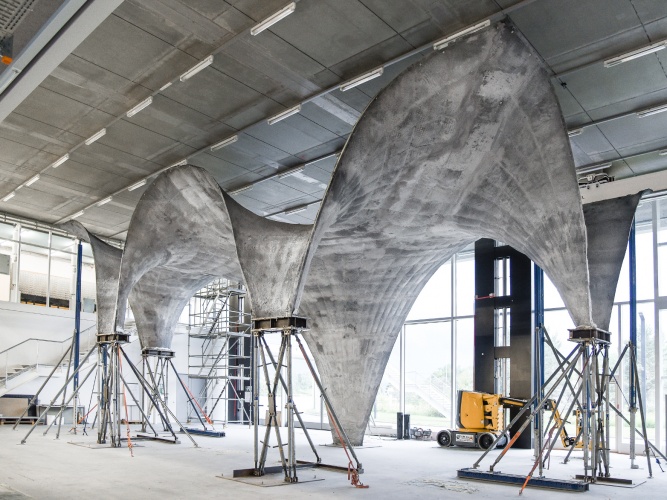
(Credit: Block Research Group, ETH Zürich/Naida Iljazovic)
The test structure, which has already been dismantled, was 7.5m high with a surface area of 160m². It was built using a framework net of steel cables covered in a polymer textile. The concrete had an average thickness of 5cm varying between 3cm along the edges of the roof to 12cm at the support surfaces.
Using algorithms developed in collaboration with the Swiss National Centre of Competence (NCCR) in Digital Fabrication, the team was able to build the steel net so that it took on the desired structural shape when the concrete was sprayed. The cable net weighed just 500kg and the textile 300kg, meaning 800kg of material was required to support the 20 tons of wet concrete.
“We’ve shown that it’s possible to build an exciting thin concrete shell structure using a lightweight, flexible formwork, thus demonstrating that complex concrete structures can be formed without wasting large amounts of material for their construction,” said Philippe Block, Professor of Architecture and Structures at ETH Zurich, and leader of the research group.
Block’s team built the structure over the course of six months in ETH Zurich’s Robotic Fabrication Lab. While only a prototype, a fully functional version is intended for the roof of an apartment unit called HiLo, due to be built next year on the NEST, a living lab building in Dübendorf, near Zurich. The real-life roof will also feature a thin layer of photovoltaic cells on the concrete’s exterior.
“Because we developed the system and built the prototype step by step with our partners from industry, we now know that our approach will work at the NEST construction site,” said Block.




Project to investigate hybrid approach to titanium manufacturing
Sadly they will not be ordering any more presses from Wilkins & Mitchell http://www.historywebsite.co.uk/articles/Darlaston/WM.htm